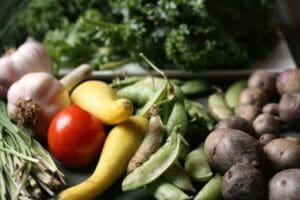10 Ways to Sneak Those Fruits & Veggies Into Your Diet

Almost everyone would like to eat more fruits and vegetables. A fresh and colorful diet is one of the biggest contributing factors to overall health, and fruits and vegetables deliver powerful doses of the nutrients and minerals needed for our bodies and minds to function at optimal levels.
The problem is that eating fruits and vegetables can be a pain. Produce must be washed, cut, prepared and eaten before it goes bad, which it will before anything else in the refrigerator. It often seems like our busy lives don’t have time to prepare fruits and vegetables, but there are many ways to sneak them into your diet. Here’s how.
All-You-Can-Eat: Institute an “all-you-can-eat” policy with fresh fruits and vegetables in your mind, just like Weight Watchers has done with their strict dieting plans. With few calories compared to their content of fiber and nutrients, fresh produce won’t make you fat – but it will make you full. Allow yourself as many fresh fruits and vegetables during the day as you want to eat. (Note: this does not include ranch dressing on those carrot sticks).
Berries: Needing no preparation besides a quick wash, organic blueberries, blackberries and raspberries are easy to eat every day. Yes, they can be expensive, but the value added to your health by these super fruits may well exceed their monetary cost. Resolve to always give yourself permission to buy a carton of berries on your grocery trip – your health is worth it, and you will find yourself eating these easy to prepare, “treat” fruits more often than not.
Breakfast is the perfect time to eat some fruits and vegetables, and you are setting yourself up for an entire day of healthy eating. Both cold cereal and hot oatmeal should always be eaten with fruit: sliced bananas, fresh berries, chunks of peaches or pears all taste delicious on your breakfast. Cooking oatmeal? Defrost a handful of frozen fruit for the bottom of your oats, and you will get a natural sweetener as well. Pancake and waffle batters also make an ideal home for pieces of fruit, especially pineapple, berries or banana.
If you prefer eggs for breakfast, always cook them with vegetables. It takes two or three minutes to chop off some onion and broccoli florets, and just a few minutes more to sauté them nicely before adding an egg to cook your way. Whatever vegetables you have on hand will go well with eggs: mushrooms, Brussels sprouts, carrots, peppers, tomatoes, endive, squash and cabbage. Add a glass of fresh juice to your breakfast, and you have started the day already with a few servings of produce!
Frozen Pizza: When you indulge in a frozen pizza, make it a bit healthier by throwing a big handful of vegetables on top before you bake it: sliced peppers, mushrooms, onions, olives, spinach and tomatoes all work wonderfully.
Meats: Cooking a big batch of beef, chicken or pork? Toss in vegetables such as beans, peppers, onions, broccoli or carrots as you cook, which will not only make your meal healthier but will also stretch your budget, as vegetables are cheaper than meat.
Pasta: Boiling a pot of rotini, spaghetti or farfalle? Throw in a big handful of chopped vegetables and make your macaroni and cheese slightly healthier. Frozen organic vegetables work very well for this, such as broccoli florets, cauliflower and peppers – just drain them along with your pasta, add sauce and enjoy!
Sandwiches: Stack your ham and cheese not only with lettuce, but also with sliced cucumbers, spinach, peppers, fresh herbs and more. Gussy up your grilled cheese with slices of fresh tomatoes or zucchini for a tasty treat.
Sliced Citrus: Do you drink 8 glasses of water a day? Top each with a slice of lemon, lime, orange or other citrus for a quick and easy burst of flavor, as well as vitamin C.
Tuna Salad: Tuna salad can be made with just tuna fish and mayo – or you could step up your game and add crunchy fruits and vegetables to make it better. Try chopped apples, grapes, celery, cucumber, tomatoes, corn or spinach and add some kick to the usual. This trick also works well for chicken salad!
Vegetable Stock: Use vegetable stock instead of water or chicken broth for recipes that call for it, such as rice, beans and casseroles.
image: thebittenword.com

